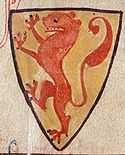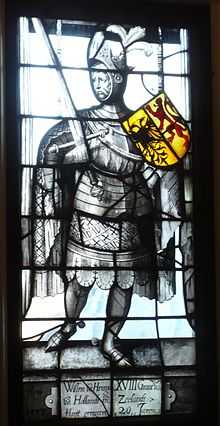William II of Holland
| William II, Count of Holland | |
|---|---|
 Count Willem II of Holland Granting Privileges by Caesar van Everdingen and Pieter Post, 1654 | |
| Spouse(s) | Elisabeth of Brunswick-Lüneburg |
|
Issue | |
| Noble family | House of Holland |
| Father | Floris IV, Count of Holland |
| Mother | Matilda of Brabant |
| Born | February 1227 |
| Died | 28 January 1256 (aged 28) |
William II of Holland (February 1227 – 28 January 1256) was a Count of Holland and Zeeland (1235–56). He was elected as German anti-king in 1247 and remained king until his death.
Life

He was the son of Floris IV and Matilda of Brabant. When his father was killed at a tournament at Corbie, William was only seven years old. His uncles, William and Otto (Bishop of Utrecht), were his guardians until 1239.

With the help of Henry II, Duke of Brabant and the archbishop of Cologne, he was elected in octobre 1247, at age 20,[1][2] as king of Germany after Emperor Frederick II was excommunicated. After a siege of five months, he took Aachen in 1248 from Frederick's followers. Only then could he be crowned as king. He gained a certain amount of theoretical support from some of the German princes after his marriage to Elizabeth, daughter of Otto the Child, Duke of Brunswick-Lüneburg, in 1252; but, although "William lacked neither courage nor chivalrous qualities... his power never extended beyond the Rhineland."[3]
In his home county, William fought with Flanders for control of Zeeland. He made himself (being king of Germany) count of Zeeland. In July 1253, he defeated the Flemish army at Westkapelle (in modern-day Belgium) and a year later a cease-fire followed. His anti-Flemish policy worsened his relationship with France.
From 1254, he fought a number of wars against the West Frisians. He built some strong castles in Heemskerk and Haarlem and created roads for the war against the Frisians.
William gave city rights to Haarlem, Delft, 's-Gravenzande and Alkmaar. A castle he had built in 1248 was the beginning of the city of The Hague.
Death
In battle near Hoogwoud on 28 January 1256, William tried to traverse a frozen lake by himself, because he was lost, but his horse fell through the ice. In this vulnerable position, William was killed by the Frisians, who secretly buried him under the floor of a house. His body was recovered 26 years later by his son Floris V, who took terrible vengeance on the West-Frisians. William was then buried in Middelburg.[4] Contemporary sources, including the chronicle of Melis Stoke, portray William as an Arthurian hero.[5]
Ancestors
| Ancestors of William II of Holland | ||||||||||||||||||||||||||||||||||||||||||||||||||||||||||||||||||||||||||||||||||||||||||||||||||||||||||||||||||||||||||||||||||||||||||||||||||||||||||||||||||||||||||||||||||||||||||||||||||||||||||||||||||||||||||||||||||||||||||||||||||||||||||||||||||||||||||||||||||||||||||||||||||||||||||||||||||||||||||||||||||||||||||||||||||||||||||||||||||||||||||||||||||||||||||||||||||||||||||||||||||||||||||||||||||||||||||||||||||||||||||||||||||||||||||||||||||||||||||||||||||||||||||||||||||||||||||||||||||
|---|---|---|---|---|---|---|---|---|---|---|---|---|---|---|---|---|---|---|---|---|---|---|---|---|---|---|---|---|---|---|---|---|---|---|---|---|---|---|---|---|---|---|---|---|---|---|---|---|---|---|---|---|---|---|---|---|---|---|---|---|---|---|---|---|---|---|---|---|---|---|---|---|---|---|---|---|---|---|---|---|---|---|---|---|---|---|---|---|---|---|---|---|---|---|---|---|---|---|---|---|---|---|---|---|---|---|---|---|---|---|---|---|---|---|---|---|---|---|---|---|---|---|---|---|---|---|---|---|---|---|---|---|---|---|---|---|---|---|---|---|---|---|---|---|---|---|---|---|---|---|---|---|---|---|---|---|---|---|---|---|---|---|---|---|---|---|---|---|---|---|---|---|---|---|---|---|---|---|---|---|---|---|---|---|---|---|---|---|---|---|---|---|---|---|---|---|---|---|---|---|---|---|---|---|---|---|---|---|---|---|---|---|---|---|---|---|---|---|---|---|---|---|---|---|---|---|---|---|---|---|---|---|---|---|---|---|---|---|---|---|---|---|---|---|---|---|---|---|---|---|---|---|---|---|---|---|---|---|---|---|---|---|---|---|---|---|---|---|---|---|---|---|---|---|---|---|---|---|---|---|---|---|---|---|---|---|---|---|---|---|---|---|---|---|---|---|---|---|---|---|---|---|---|---|---|---|---|---|---|---|---|---|---|---|---|---|---|---|---|---|---|---|---|---|---|---|---|---|---|---|---|---|---|---|---|---|---|---|---|---|---|---|---|---|---|---|---|---|---|---|---|---|---|---|---|---|---|---|---|---|---|---|---|---|---|---|---|---|---|---|---|---|---|---|---|---|---|---|---|---|---|---|---|---|---|---|---|---|---|---|---|---|---|---|---|---|---|---|---|---|---|---|---|---|---|---|---|---|---|---|---|---|---|---|---|---|---|---|---|---|---|---|---|---|---|---|---|---|---|---|---|---|---|---|---|---|---|---|---|---|---|---|---|---|---|---|---|---|---|---|---|---|---|---|---|---|---|---|---|---|---|---|---|---|---|---|---|---|---|---|---|---|---|---|---|---|---|---|---|---|---|---|---|---|---|---|---|---|---|---|---|---|---|---|---|---|---|---|---|---|---|---|---|---|---|---|---|---|---|---|---|---|---|---|
| ||||||||||||||||||||||||||||||||||||||||||||||||||||||||||||||||||||||||||||||||||||||||||||||||||||||||||||||||||||||||||||||||||||||||||||||||||||||||||||||||||||||||||||||||||||||||||||||||||||||||||||||||||||||||||||||||||||||||||||||||||||||||||||||||||||||||||||||||||||||||||||||||||||||||||||||||||||||||||||||||||||||||||||||||||||||||||||||||||||||||||||||||||||||||||||||||||||||||||||||||||||||||||||||||||||||||||||||||||||||||||||||||||||||||||||||||||||||||||||||||||||||||||||||||||||||||||||||||||
References
- ↑ Text on monument in Rijnsburg, Katwijk, the Netherlands .
- ↑ IJpelaan.nl Archive Graven Willem II
- ↑ Kantorowicz, Ernst, Frederick II, p. 638.
- ↑ Graaf, Ronald P. de (2004). Oorlog om Holland, 1000-1375. Verloren. pp. 231ff. ISBN 9789065508072.
- ↑ Tom Verschaffel, ed. (2000). Koningsmoorden. Leuven UP. pp. 150ff. ISBN 9789058670731.
See also
| William II of Holland House of Holland Born: Febaurary 1228 Died: 28 January 1256 | ||
| Preceded by Floris IV |
Count of Holland and Zeeland 1235–1256 |
Succeeded by Floris V |
| Preceded by Henry Raspe (as anti-king) |
King of Germany (formally King of the Romans) 1247–1256 (anti-king to Conrad IV until 1254) |
Succeeded by Richard of Cornwall and Alfonso of Castile |
|